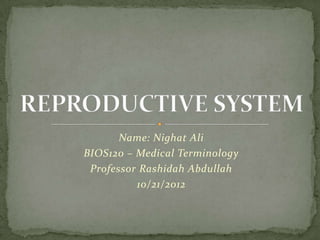
Chap 10 reproductive system
- 1. Name: Nighat Ali BIOS120 – Medical Terminology Professor Rashidah Abdullah 10/21/2012
- 2. Reproduction is the process by which organisms make more organisms like themselves In the reproductive process, two kinds of sex cells, or gametes, are involved. The male gamete (sperm) and the female gamete (egg or ovum) meet in the female's reproductive system to create a new individual. Both the male and female reproductive systems are essential for reproduction. The female needs a male to fertilize her egg, even though it is she who carries offspring through pregnancy and childbirth.
- 3. Female Reproductive System Male Reproductive System
- 4. Menopause is time in a woman’s life when her menstruation stops and the body goes through changes that usually does not allows her to get pregnant. Usually for women between 45 – 55 During menopause, woman’s ovaries stop making eggs and produce less estrogen and progesterone, which cause menopause symptoms. Menopause is complete when a woman have not had period for 1 year, known as postmenopause. Women who are postmenopausal can no longer get pregnant.
- 5. Symptoms of menopause vary from woman to woman. First thing, period will start to change. It may occur more or less often. Some women get period every 3 weeks, which may last for 1 – 3 years before periods completely stop Symptoms of menopause may include: heart pounding, skin flushing, insomnia, night sweats, urine leakage, mood swings, vaginal infections, etc Test results can help in determining if a woman is close to menopause or if already gone through menopause. These tests include Estradiol, FSH – follicle stimulating hormone, or LH – luteinizing hormone blood test. Treatment for menopause depends on how bad symptoms are, overall health, and preference. It may include lifestyle changes or hormone therapy.
- 6. Eggs (or ova) are produced in the female sex glands (ovaries) and are the largest cells in the human body. The egg is round in shape and it contains 23 chromosomes, which carry woman’s inheritable characteristics. Unlike sperm cells, egg contain X chromosomes. However, the sex of a child is not determined by the content of the egg, but by that of the sperm. Once female sex glands have matured during puberty, they normally release not more than one egg per month. Unless the egg is fertilized by a sperm while in the fallopian tube, the egg dries up and leaves the body about 2 weeks later through the uterus – this is menstruation Fertilized egg is called zygote
- 8. Endometrium is the inner layer of the uterine wall contains a rich blood supply. It reacts to hormonal changes every month that prepare it to receive a fertilized ovum. It serve as a place for an embryo to implant and become nourished by it's rich blood supply. It serves as a lubricating film barrier to keep the uterine walls from adhering to each other. In a nonpregnant uterus, the uterine walls touch but do not stick together because of the endometrium. When this has been destroyed by ablation and removed, the uterus becomes fibrous and forms adhesions in which it collapses and grows together. To remain healthy, the uterus needs an endometrium of at least 4-5 mm.
- 9. There is also endometrial cancer, which begins in the layer of cells that form the lining (endometrium) of the uterus. Endometrial cancer is known as uterine cancer, which is detected at an early stage because of abnormal vaginal bleeding. Other symptoms may include: pelvic pain, pain during intercourse, and abnormal, watery discharge from vagina Doctors do not know what causes endometrial cancer. Only thing known is that something occurs to create a genetic mutation within cells in the endometrium. Tests for this cancer include: pelvic examination, transvaginal ultrasound, and hysteroscopy.
- 10. The treatments usually result in surgery to remove the uterus, but other options available are radiation therapy, hormone therapy, and chemotherapy In order to prevent endometrial cancer, maintain healthy weight, get examined regularly (specially after menopause), consider taking birth control pills, and exercise regularly.
- 11. Hope you enjoyed and learned Thank you !!!